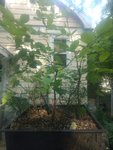@0soyoung - one of the common names for Carpinus virginiana is loose flowered hornbeam. The seed structure is loose, and to my eye not at all like a hop. The appearance of the seed structure of Ostyra is fairly tight, very much appears like a hop, Humulus seed structure. I forget the botanical name for these structures.
As said above Ostrya virginiana has a flaky bark that is quite different than Carpinus caroliniana. I found Ostrya are usually found in slightly more upland, hence less moist habitats than Carpinus. Both like moisture, but Ostrya always seems to be above the flood plain, where Carpinus can be in the secondary flood plain. Ostrya has a slightly better tolerance of brief droughts than Carpinus, though they do not like to get bone dry. A carpinus might loose branches if allowed to dry to wilt point immediately. Ostrya has kept fine branches even though they were wilted for most of a whole day. Don't let them dry to wilt, a second day wilted they start dying. Best to keep evenly moist. But Ostrya are definitely a little bit more drought tolerant than Carpinus.
Seedlings seem to take well to bonsai potting mix. I have had no experience transplanting more mature trees. Given their more upland habit, the soils are likely deeper, hence roots are deeper, making Ostrya more difficult to collect.
Overall, they seem to have similar ability for fine twiggy branching as Carpinus caroliniana. All in all, once you have a good root system developed, probably just as good for bonsai as Carpinus. I like 'em, though I've only been working with seedlings so far.
some Ostrya seedlings I'm growing in an Anderson flat.






